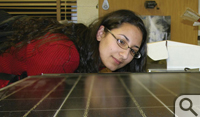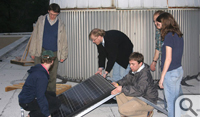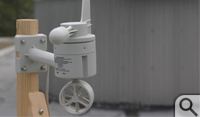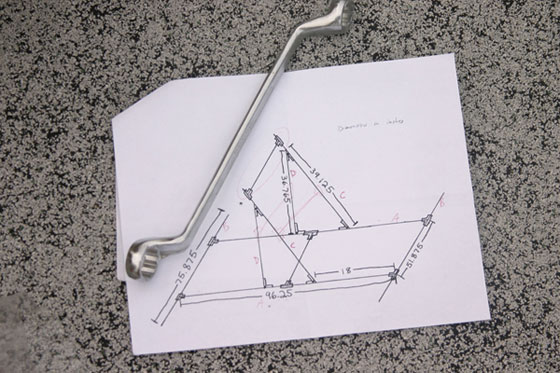SCORS: The scientific approach to solar energy on campus
The idea is to harness the sun to generate electricity, but first the people in SCORS had to know which photovoltaic technology is best to use. And to determine that, they first needed to know more about the weather.
"We found out that depending on the conditions-the humidity and the temperature-different types of solar cells will work better or worse," explained Irina Novikova. She, along with Eugeniy Mikhailov and Seth Aubin, are the three members of the physics department working most closely with students in SCORS.
SCORS is the acronym for Solar Cells On the Roof of Small, an enterprise to evaluate the viability of using solar panels to supplement campus electric power. SCORS is one of the experimental initiatives funded by the William and Mary Committee on Sustainability, a blue-ribbon panel charged with implementing a College policy to make improvements to the campus environment.
Itself an activity of the William and Mary Society of Physics Students, SCORS is using the flat rooftop of Small Hall, the physics building at William and Mary, to test various solar technologies to determine the optimum setup for use in Williamsburg. SCORS is approaching the problem with an open mind regarding what the final product might be.
"As scientists we think that the most efficient is the one which generates the most power per dollar," Mikhailov said. "But our report might also include proper choice of inverter, the best battery for storage of energy, wiring system price and so on."
A model for solar power
 Once the best system is found, the goal is to
incorporate a large-scale solar station into the scheduled renovation of Small
Hall, thereby establishing a model for other solar projects across campus.
Once the best system is found, the goal is to
incorporate a large-scale solar station into the scheduled renovation of Small
Hall, thereby establishing a model for other solar projects across campus.
The task of identifying the best photovoltaic panel for the unique weather conditions of Williamsburg should have been a straightforward evaluation of manufacturers' literature and technical specs, but it didn't work out that way. For example, the largest panel being evaluated by SCORS has a manufacturer's rating of 176 watts, which Mikhailov explained represents peak power on a sunny day.
"We haven't seen that number yet-and for a cloudy day, we are getting barely 30 watts at peak," he said.
"There are several technologies and all of them will tell you they are the best," Novikova said. "So to really make an educated choice about what kind of system is best, we need to know what kind of weather we expect. That's why we need a weather station."
An eye on the weather
 The need for detailed, local weather data became clear
early in the process. SCORS received COS funding in December and soon got
started, meeting with Alan Compaan, a photovoltaics thin-film researcher from
the University of Toledo.
Five test panels arrived over winter break. Four of the panels are small five-
or six-watt devices, such as you might see attached to an illuminated roadside
highway sign. The largest, the one rated for 176 watts, is about the size of a
tabletop. The test panels represent a range of vendors and technologies, from
multicrystalline silicon to thin-film copper indium gallium diselenide.
The need for detailed, local weather data became clear
early in the process. SCORS received COS funding in December and soon got
started, meeting with Alan Compaan, a photovoltaics thin-film researcher from
the University of Toledo.
Five test panels arrived over winter break. Four of the panels are small five-
or six-watt devices, such as you might see attached to an illuminated roadside
highway sign. The largest, the one rated for 176 watts, is about the size of a
tabletop. The test panels represent a range of vendors and technologies, from
multicrystalline silicon to thin-film copper indium gallium diselenide.
The weather station was installed in February, with data transmitted to a computer inside the Small Hall rooftop observatory. Much thought went into the next challenge: how to mount the panels.
"Mounting is the hardest thing in terms of research involved," Novikova explained. "It sounds simple-you hook the battery up and you measure what comes out-but the tests have to be very carefully designed to give meaningful results."
By spring break, the testing procedures were worked out and the SCORS team began mounting their test panels. As a temporary measure, the large panel had been set up, resting flat on a couple of pieces of boards.
"The most efficient mounting is perpendicular to the sun," Jeffrey Brown '09 explained as he and other SCORS members assembled a mounting rack fabricated for the big panel in April. "The sun moves, though, but we figured a dynamic system-to follow the sun-would be too expensive."
 The rack for the large panel was designed to be inclined
to match the sun's altitude. Novikova said the output of the five test panels
will be monitored throughout the summer, and SCORS will use the data in
calculating the final design.
The rack for the large panel was designed to be inclined
to match the sun's altitude. Novikova said the output of the five test panels
will be monitored throughout the summer, and SCORS will use the data in
calculating the final design.
Mikhailov said the final design will likely consist of an array of 100 to 200 solar panels. The number of panels is limited by budget, rather than the rooftop area of Small Hall, he added. There are a number of practical, as well as scientific, considerations yet to be addressed. For example, SCORS will have to work with the requirements of maintenance personnel and the wiring system is a project all its own. The final design may or may not include a battery system, as well.
"At the current rate, Small will eat up everything we can provide," Mikhailov said, "but we might consider battery storage for the power interruption cases. Our scientific equipment desperately needs reliable power. There are couple of setups which must be on for all 24 hours."
SCORS is one of a number of campus sustainability
projects, funded through a student "Green Fee" that was announced by William
& Mary President Taylor Reveley in the Spring of 2008. The solar cell
project was one of the first five projects approved by the Committee on
Sustainability, chaired by Lynda Butler, Chancellor Professor and interim dean
at the School of Law
and Dennis Taylor, professor at the School
of Marine Sciences. 















